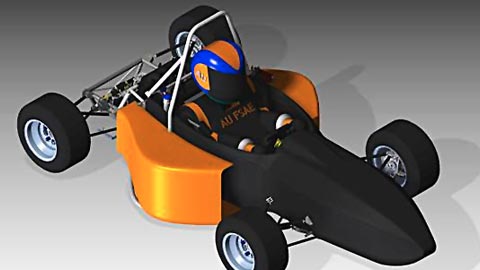Easy-to-use CAD that enables self-teaching
Easy-to-use CAD that enables self-teaching

Case Study
Using Solid Edge, Auburn University’s Formula SAE Team earns its best finish in an international competition; multiple awards received
Auburn University Formula SAE
Team reduces space frame weight by 10 lbs., with 65 percent gain in torsional stiffness
The unique challenge of FSAE
In addition to a rich history of winning football teams, students at Auburn University can be proud of its success in the automotive sports world, with a bestever team finish in 2013. The Auburn Formula FSAE team combined design, manufacturing, teamwork and ingenuity to place second at the Formula SAE race in Lincoln, Nebraska.
The unique challenge of FSAE is that it is an educational project with a motorsports timeline. The student team has effectively three months to design every part of the car, and roughly half of Auburn’s designers this year are returning freshmen with no computer-aided design (CAD) experience. Every part on the car must be modeled, down to each nut and bolt. Under these time constraints, a significant number of the vehicle’s parts must be drawn, analyzed, and then iterated to find the optimum part. Moreover, weight reduction to improve speed is one of the driving forces in achieving a competitive advantage.
Two groups
The car design is handled by two groups. A Powertrain group, led by a chief engineer, has six section leaders in charge of designing specific parts of the car. These sections include engine internals, intake, exhaust, electronics, fluids and drivetrain. The Chassis group, also led by a chief engineer, includes eight sections: frame, suspension kinematics, brake, tire dynamics, structure/wheel sets, wheel research and development (R&D), and ergonomics.
“Data integration, the ability to share information and cross-team collaboration are critical to success,” notes Andrew Rains, a Marketing major in the School of Business at Auburn and the FSAE team captain.
